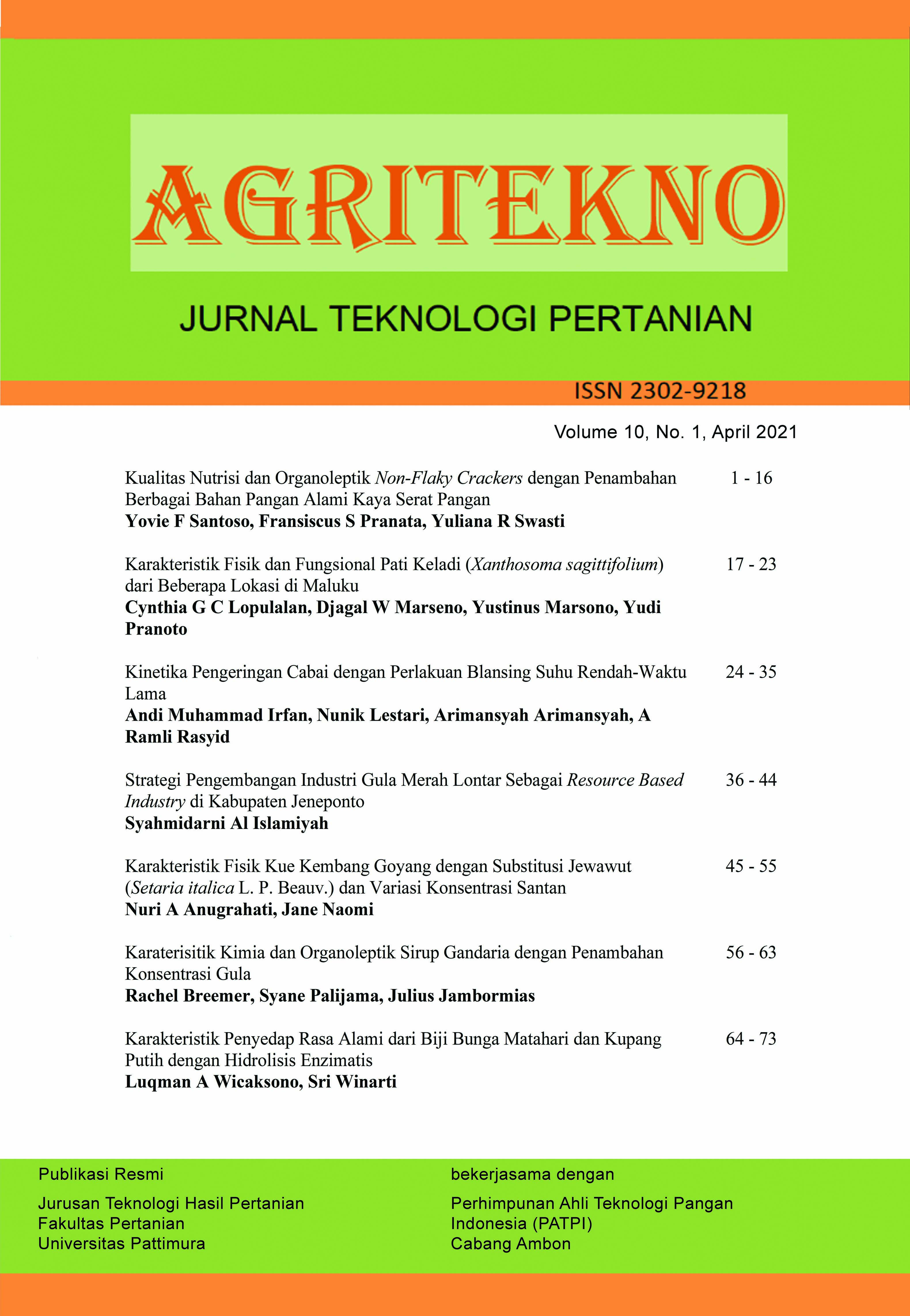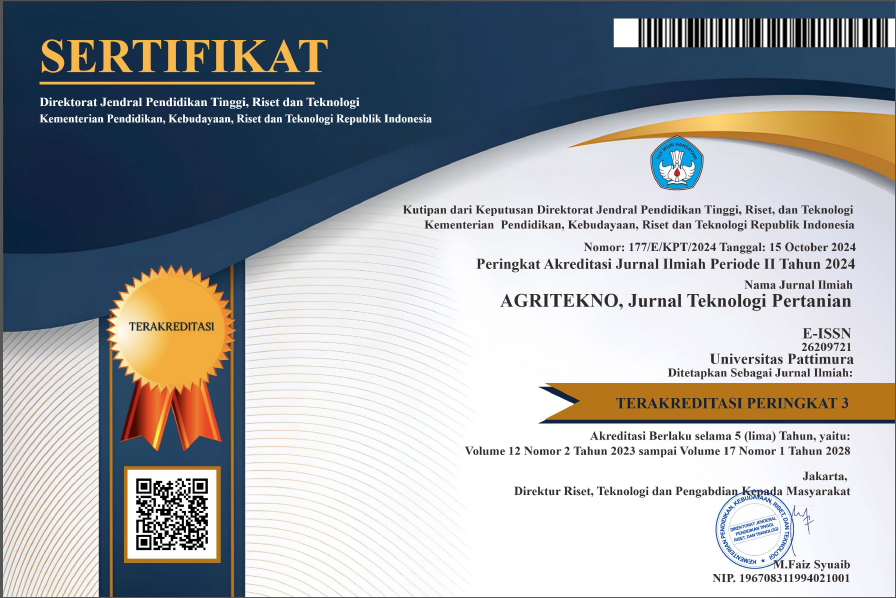Karakteristik Fisik Kue Kembang Goyang dengan Substitusi Jewawut (Setaria italica L. P. Beauv.) dan Variasi Konsentrasi Santan
Physical Characteristics of Kue Kembang Goyang with Foxtail Millet (Setaria italica L. P. Beauv.) Substitution and Variation of Coconut Milk Concentration
Abstract
“Kue kembang goyang†is a popular Indonesian traditional food made from rice flour. Millet flour with an amylose content equal to rice flour can be substituted for rice flour in the “kue kembang goyang†formulation. The research aimed to determine the amylose content of 3 varieties of foxtail millet flour (Setaria italica (L.) P. Beauv.) and to determine the best formula of “kue kembang goyang†in several ratios of foxtail millet flour:rice flour-based on crunchiness and oil absorption. The research was divided into two phases. Phase I, involved determining the amylose content of the three varieties of foxtail millet flour (erecta, compacta, glabra) and stage II involved determining the physical characteristics of “kue kembang goyang†in the ratio of foxtail millet flour:rice flour (0: 100, 20:80, 40:60, 60:40, 80:20) and concentration of coconut milk (20%, 30%, 40%). The result of phase I showed that the highest amylose content was found in foxtail millet flour of erecta variety (37.91 ± 0.51%). The phase II result showed that the ratio of foxtail millet flour:rice flour affected the texture and absorption of oil of “kue kembang goyangâ€. The higher the ratio of foxtail millet flour, the lower the count peaks, toughness, oil absorption, but the higher fracturability of “kue kembang goyangâ€. Increasing the concentration of coconut milk can increase count peaks, toughness, fracturability, and an oil absorption of “kue kembang goyangâ€. The best formula of “kue kembang goyang†was obtained in the ratio of foxtail millet flour:rice flour 60:40 and 30 % of coconut milk-based on the highest crunchiness and oil absorption resembled the control.
Keywords: Coconut milk; foxtail millet; “kue kembang goyangâ€; physical characteristics
ABSTRAK
Kue kembang goyang merupakan kue tradisional Indonesia yang popular dan terbuat dari tepung beras. Tepung beras dalam formula kue kembang goyang dapat diganti tepung jewawut yang memiliki kadar amilosa menyamai tepung beras. Tujuan penelitian adalah menentukan kadar amilosa tiga varietas tepung jewawut (Setaria italica (L.) P. Beauv.) dan menentukan formula terbaik kue kembang goyang pada beberapa rasio tepung jewawut:tepung beras berdasarkan kerenyahan dan absorpsi minyak. Penelitian dibagi menjadi tahap I yaitu menentukan kadar amilosa ke-3 varietas jewawut (erecta, compacta, glabra) dan tahap II yaitu menentukan karakteristik fisik kue kembang goyang pada rasio tepung jewawut:tepung beras (0:100, 20:80, 40:60, 60:40, 80:20) dan konsentrasi santan (20, 30, 40%). Hasil penelitian tahap I menunjukkan kadar amilosa tertinggi pada tepung jewawut varietas erecta (37,91 ± 0,51%). Hasil penelitian tahap II menunjukkan rasio tepung jewawut:tepung beras berpengaruh terhadap tekstur dan absorpsi minyak kue kembang goyang. Semakin tinggi rasio tepung jewawut dapat menurunkan count peaks, toughness, absorpsi minyak, namun meningkatkan daya patah kue kembang goyang. Peningkatan konsentrasi santan dapat meningkatkan count peaks, toughness, daya patah, dan absorpsi minyak kue kembang goyang. Formula terbaik kue kembang goyang diperoleh pada rasio tepung jewawut:tepung beras 60:40 dan konsentrasi santan 30% berdasarkan kerenyahan tertinggi dan absorpsi minyak yang menyerupai kontrol.
Kata kunci: Karakteristik fisik; kue kembang goyang; jewawut; santan
Downloads
References
Andarwulan, N., F. Kusnandar, dan Herawati. 2011. Analisis Pangan. Jakarta: Dian Rakyat. 328 hal.
Andayani, R. 2013. Diversifikasi tepung cassava dalam pembuatan sagon, kembang goyang dan kecipir. Jurnal Khasanah Ilmu 4: 91-99. DOI:10.31294/khi.v4i1.467.
Annor, G.A., M. Marcone, E. Bertoft, and K. Seetharaman. 2014. Physical and molecular of millet starches. Cereal Chemistry 91: 286-292. DOI:10.1094/CCHEM-08-13-0155-R.
AOAC. 2012. Official Methods of Analysis of AOAC International. The Association Official Analytical Chemists. Rockville, MD. Methods 2002.02.
Chen, L., D.J. McClements, H. Zhang, Z. Zhang, Z. Jin, and Y. Tian. 2019. Impact of amylose content on structural changes and oil absorption of fried maize starches. Food Chemistry 287: 28-37. DOI:10.1016/j.foodchem.2019.02.083.
Fernando, B. 2013. Rice as a source of fiber. Journal of Rice Research 1: 1-4. DOI:10.4172/jrr.1000e101.
Fuadah, I.E. dan C.A.N. Afifah. 2016. Pengaruh penambahan tepung bekatul terhadap mutu organoleptik kue kembang goyang. E-journal Boga 5: 18-26.
Gao, H., J. Cai, W. Han, H. Huai, Y. Chen, and C. Wei. 2014. Comparison of starches isolated from three different Trapa species. Food Hydrocolloids 37: 174-181. DOI:10.1016/j.foodhyd.2013.11.001.
Harijono, W.H. Susanto, dan F. Ismet. 2012. Studi penggunaan proporsi tepung (sorgum ketan dengan beras ketan) dan tingkat kepekatan santan yang berbeda terhadap kualitas kue semprong. Jurnal Teknologi Pertanian 2: 1-11.
Hijrianti, S. dan S. Widodo. 2018. Substitusi tepung jewawut pada kue kassipiq di Desa Bonde Kecamatan Campalagian Kabupaten Polewali Mandar. Prosiding Seminar Nasional Sinergitas Multidisiplin Ilmu Pengetahuan dan Teknologi (SMIPT) 9-10 April 2018, Indonesia. pp. 294-300.
Himabindu, P. dan N. Devanna. 2017. Development of nutritious cookies by incorporating kodo and little millet flour. International Journal of Agriculture Science and Research 7: 681-688.
Juhaeti, T., W. Widiyono, N. Setyowati, P. Lestari, F. Syarif, Saefuddin, I. Gunawan, Budiarjo, dan R.H. Agung. 2019. Serealia lokal jewawut (Setaria italica (L.) P. Beauv.: Gizi, budaya dan kuliner. Prosiding Seminar Nasional Biologi, Saintek, dan Pembelajaran-nya (SN-Biosper) 28 September 2019, Tasikmalaya, Indonesia. pp. 9-17.
Lumanlan, J.C., W.M.A.D.B. Fernando, and V. Jayasena. 2019. Mechanisms of oil uptake during deep frying and applications of predrying and hydrocolloids in reducing fat content of chips. International Journal of Food Science and Technology. DOI:10.1111/ijfs.14435.
Luna, P., H. Herawati, S. Widowati, dan A.B. Prianto. 2015. Pengaruh kandungan amilosa terhadap karakteristik fisik dan organoleptik nasi instan. Jurnal Penelitian Pascapanen Pertanian 12: 1-10. DOI:10.21082/jpasca.v12n1.2015.1-10.
Mamat, H. and E.S. Hill. 2014. Effect of fat types on the structural and textural properties of dough and semi-sweet biscuit. Journal of Food Science and Technology 51: 1998–2005. DOI:10.1007/s13197-012-0708-x.
Manjunatha, S.S., N. Ravi, P.S. Negi, P.S. Raju, and A.S. Bawa. 2014. Kinetics of moisture loss and oil uptake during deep fat frying of Gethi (Dioscorea kamoonensis Kunth) strips. Journal of Food Science and Technology 5: 3061-3071. DOI:10.1007/s13197-012-0841-6.
Mousa, R.M.A. 2016. Hydrocolloids of date pits used as edible coating to reduce oil uptake in potato strips during deep-fat frying. Journal of Food Science and Technology 13: 39-50.
Paula, A.M. and A.C. Conti-Silva. 2014. Texture profile and correlation between sensory and instrumental analyses on extruded snacks. Journal of Food Engineering 121: 9-14. DOI:10.1016/j.jfoodeng.2013.08.007.
Paz-Gamboa, E., E. Ramirez-Figueroa, M.A. Vivar-Vera, H.R. Bravo-Delgado, O. Cortes-Zavaleta, H. Ruiz-Espinosa, and I.I. Ruiz-Lopez. 2015. Study of oil uptake during deep-fat frying of Taro (Colocasia esculenta) chips. CyTA Journal of Food 13: 506-511. DOI:10.1080/19476337.2015.1010587.
Raigond, P., R. Ezekiel, and B. Raigond. 2014. Resistant starch in food: A review. Journal of the Science of Food and Agriculture 95: 1968-1978. DOI:10.1002/jsfa.6966.
Rathore, S., K. Singh, and V. Kumar. 2016. Millet grain processing, utilization and its role in health promotion: A review. International Journal of Nutrition and Food Sciences 5: 318-329. DOI:10.11648/j.ijnfs.20160505.12.
Sarita and E. Singh. 2016. Potential of millets: nutrients composition and health benefits. Journal of Scientific and Innovative Research 5: 46-50.
Widiyawati, E., N. Ratnaningsih, dan B. Lastariwati. 2020. Uji kesukaan dan kandungan gizi millet crispy dari tepung millet sebagai snack alternatif sumber serat. Warta Industri Hasil Pertanian 37:66-73. DOI:10.32765/wartaihp.v37i1.5907.
Yadav, D.N. and A. Rajan. 2011. Fibers as an additive for oil reduction in deep fat fried poori. Journal of Food Science and Technology 49: 767-773. DOI:10.1007/s13197-010-0218-7.
Copyright (c) 2021 Nuri A Anugrahati, Jane Naomi

This work is licensed under a Creative Commons Attribution-ShareAlike 4.0 International License.
Authors who publish with this journal agree to the following terms:
- Authors retain copyright and grant the journal the right of first publication with the work simultaneously licensed under a Creative Commons Attribution License that allows others to share the work with an acknowledgement of the work's authorship and initial publication in this journal.
- Authors are able to enter into separate, additional contractual arrangements for the non-exclusive distribution of the journal's published version of the work (e.g., post it to an institutional repository or publish it in a book), with an acknowledgement of its initial publication in this journal.
- Authors are permitted and encouraged to post their work online (e.g., in institutional repositories or on their website) prior to and during the submission process, as it can lead to productive exchanges, as well as earlier and greater citation of published work (See The Effect of Open Access).









